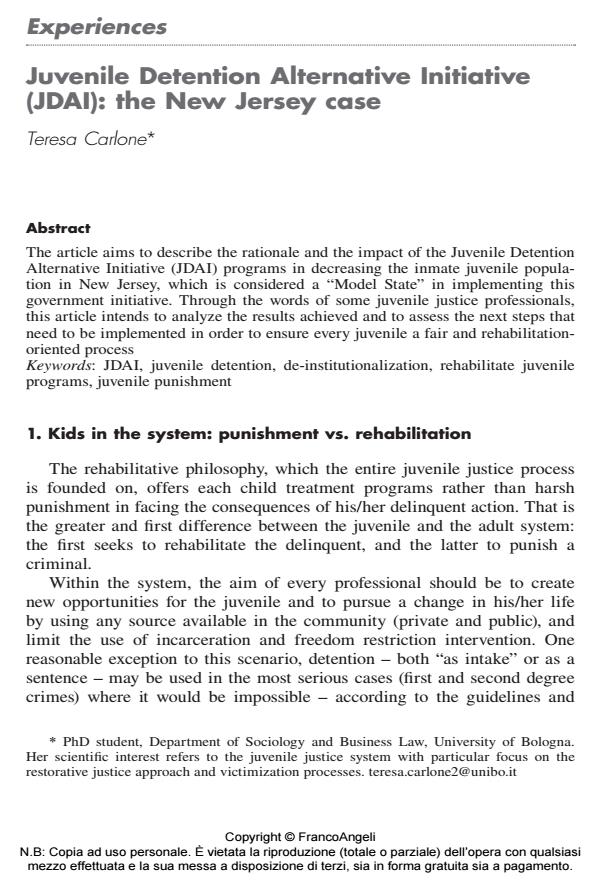Juvenile Detention Alternative Initiative (JDAI): the New Jersey case
Titolo Rivista SICUREZZA E SCIENZE SOCIALI
Autori/Curatori Teresa Carlone
Anno di pubblicazione 2015 Fascicolo 2015/2 Lingua Inglese
Numero pagine 11 P. 111-121 Dimensione file 94 KB
DOI 10.3280/SISS2015-002008
Il DOI è il codice a barre della proprietà intellettuale: per saperne di più
clicca qui
Qui sotto puoi vedere in anteprima la prima pagina di questo articolo.
Se questo articolo ti interessa, lo puoi acquistare (e scaricare in formato pdf) seguendo le facili indicazioni per acquistare il download credit. Acquista Download Credits per scaricare questo Articolo in formato PDF

FrancoAngeli è membro della Publishers International Linking Association, Inc (PILA)associazione indipendente e non profit per facilitare (attraverso i servizi tecnologici implementati da CrossRef.org) l’accesso degli studiosi ai contenuti digitali nelle pubblicazioni professionali e scientifiche
The article aims to describe the rationale and the impact of the Juvenile Detention Alternative Initiative (JDAI) programs in decreasing the inmate juvenile population in New Jersey, which is considered a "Model State" in implementing this government initiative. Through the words of some juvenile justice professionals, this article intends to analyze the results achieved and to assess the next steps that need to be implemented in order to ensure every juvenile a fair and rehabilitationoriented process
Keywords:JDAI, juvenile detention, de-institutionalization, rehabilitate juvenile programs, juvenile punishment
- Annie E. Casey Foundation (2014). Juvenile Detention Alternative Initiative 2013 Annual Results Report. Baltimore: Annie E. Casey Foundation.
- Benekos P.J., Merlo A.V., Puzzanchera C.M. (2013). In defense of children and youth: reforming juvenile justice policies. International Journal of Police Science and Management, 5(2).
- Brooks C.C., Roush D. (2014). Transformation in justice system. Reclaiming children and youth, 23(1).
- Holman B., Ziedenberg J. (2006). The danger of detention: the impact of incarcerating youth in detention and other secure facilities. Justice Policy Institute. Washington, DC.
- Garland D. (2001). The Culture of Control: Crime and Social Order in Contemporary Society. Chicago: University of Chicago Press.
- Mendel R. (2011). No place for kids. The case of reducing juvenile incarceration. Baltimore: Annie E. Casey Foundation. Office of the Attorney General - Juvenile Justice Commission, New Jersey Juvenile Detention Alternatives Initiative (JDAI) 2013 Annual Data Report, March 2014.
- Smith D.J. (2005). The effectiveness of the juvenile justice system. Criminology and Criminal Justice, 5(2): 181-195. DOI: 10.1177/1466802505053497
- Soler M., Garry L.M. (2009). Reducing Disproportionate Minority Contact: preparation at the local level. Office of Juvenile Justice and Delinquency Prevention. Available at the web site www.ojp.usdoj.gov/ojjdp.
Teresa Carlone, Juvenile Detention Alternative Initiative (JDAI): the New Jersey case in "SICUREZZA E SCIENZE SOCIALI" 2/2015, pp 111-121, DOI: 10.3280/SISS2015-002008